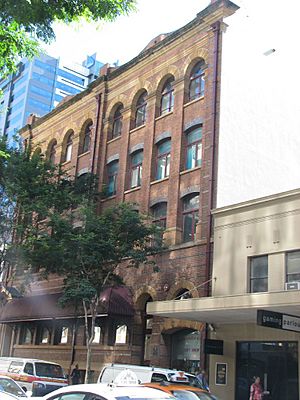Catholic Centre, Brisbane facts for kids
Quick facts for kids Catholic Centre |
|
|---|---|

Catholic Centre, 2008
|
|
| Location | 149 Edward Street, Brisbane City, City of Brisbane, Queensland, Australia |
| Design period | 1900 – 1914 (early 20th century) |
| Built | 1900 |
| Architect | Slatyer & Cosh |
| Official name: Catholic Centre, Edwards Dunlop Building | |
| Type | state heritage (built) |
| Designated | 21 October 1992 |
| Reference no. | 600091 |
| Significant period | 1900 (fabric) 1901–1974 (historical) |
| Significant components | tank stand, furniture/fittings, carriage/wagon/dray entrance |
| Lua error in Module:Location_map at line 420: attempt to index field 'wikibase' (a nil value). | |
The Catholic Centre is an old building in Brisbane City, Queensland, Australia. It used to be a large warehouse for storing goods. The building was designed by Slatyer & Cosh and finished in 1900. It's also known as the Edwards Dunlop Building. This important building is listed on the Queensland Heritage Register. This means it's protected because of its history and special design.
Contents
A Look Back: The Building's History
Early Days as a Warehouse
This building was built in 1900 for a company called Edwards Dunlop & Co Ltd. They were a paper company based in Sydney. The architects were likely Slatyer & Cosh, also from Sydney.
When it was built, the warehouse was very modern. It had an electric lift (elevator). It also had up-to-date fire safety equipment. Plus, it had a large telephone system.
Federation and Growth
Edwards Dunlop & Co Ltd started using the building on January 1, 1901. This was the same day Australia became a Federation. This timing was perfect for the company.
Becoming a Federation made it easier to trade between different states. This helped companies like Edwards Dunlop. They could now sell their paper products more easily in Queensland.
By 1910, Edwards Dunlop was the biggest paper wholesaler in Queensland. They supplied school books, exercise books, and maps. These went to schools all over the state. The company even bought more land nearby in 1925 and 1957. This made their property L-shaped, reaching to Charlotte Street.
Becoming the Catholic Centre
In 1974, Edwards Dunlop moved to a new location. The next year, the Roman Catholic Archdiocese of Brisbane bought the building. They made many changes to it.
They put in a new lift and stairs. They also built video and radio studios inside. The building was also connected to St Stephen's Cathedral. Today, many different Catholic groups use the building.
What the Building Looks Like
Outside Features
The Catholic Centre is a four-storey building with a basement. It was built during the Federation era. It uses different coloured bricks and stone.
The top three floors have tall, flat columns called pilasters. These separate the windows. The columns have simple tops, called capitals. They support stone arches above the top windows. The roof's edge, called a parapet, has four gentle curves. It also has projecting parts, called piers, in the middle and at the ends.
The front of the building, facing the street, has three entrances. The main entrance on the left has a stone triangle shape above it, called a pediment. Another entrance was used for carriages. A large metal sun-hood was added later. It shades the ground floor windows and is held up by metal brackets.
The basement windows have rough-looking stone sections, called rusticated piers, between them. They are protected by decorative metal screens.
Inside and Back of the Building
The back of the building is painted. It has a tall, T-shaped arch at the top. This arch holds a water tank.
Inside, you can still see some beautiful original wooden details. The timber posts, beams, and brick walls are not painted.
Why This Building is Special
The Catholic Centre is listed on the Queensland Heritage Register. It was added on October 21, 1992. This means it's important for several reasons:
- It shows Queensland's history: The building is a great example of a Federation-era warehouse. It has a detailed brick and stone front. Much of its inside structure and wooden parts are still original.
- It shows what this type of building is like: It clearly shows the main features of a warehouse from that time.
- It's beautiful to look at: The Catholic Centre adds a lot to the look of Edward Street. This street has many old buildings from the late 1800s and early 1900s.

